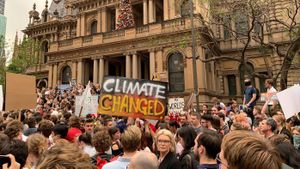Across the sweeping landscapes of America, national parks are becoming the go-to destinations for those seeking stunning views and outdoor adventures. But increasingly, these parks are also marking their territory as Instagrammable hotspots, with visitors sharing their experiences online like never before. A fresh report highlights these trends, underlining the impact of social media on tourism and the way people choose their travel destinations.
It's no surprise to hear social media influences travel plans. Indeed, as reported by Credit Karma, 37% of Americans now decide their vacation spots based at least partially on what they’ve seen on Instagram. More granular behaviors reveal even greater significance: 19% actively seek out activities driven by social media content, slightly outpacing the 17% who look for dining recommendations.
According to Casino Alpha, two national parks made their way onto the exclusive list of the top 20 most Instagrammed tourist destinations across the US, though the iconic Disneyland still holds the crown. The Grand Canyon, with its awe-inspiring vistas, received over 4.4 million posts under the hashtag #GrandCanyon, standing tall with more than 4.7 million visitors recorded by the National Park Service last year. This makes the Grand Canyon the eighth most-posted tourist attraction on Instagram.
The grandeur of the Grand Canyon, famous for its unique red rock layers, is widely appreciated not just for its visuals, but also for its educational value, demonstrating the natural erosion patterns over millennia.
Yet, as breathtaking as these places are, they still aren’t quite enough to dethrone the likes of Walt Disney World, which has soared to over 11 million photos under its hashtag. Following Disney are Universal Studios’ parks, raking in around 8.2 million posts, showcasing just how family-friendly spots dominate the social media scene.
Other natural wonders, such as Yosemite National Park, also have made their mark, circulating over 1.6 million posts under #Yosemite. Meanwhile, Big Sur, classified as a state park, just barely edges out Yosemite with approximately 1.6 million posts. Zion National Park follows closely, gathering around 1.5 million. Together, these breathtaking sites highlight not just the beauty of nature but also the relevance of digital connection as travelers never hesitate to share their picturesque views with the world.
But why do some places capture the social media spotlight more so than others? Well, as many parks continue to highlight their scenic aspects, it's the hiking trails, stunning overlooks, and wildlife encounters attracting attention. The parks’ own marketing efforts often spotlight popular spots, and certain areas become known for their photogenic qualities. With these social media algorithms, travelers are sure to post the stunning landscapes, creating even more buzz around the parks.
It's clear Instagram is not only influencing where people travel but also how they experience those places. Authorities at the National Park Service have recognized these shifts and are adapting. They've been promoting responsible photography practices, discouraging visitors from getting too close to wildlife just to get the ultimate shot. Their guidelines echo loud and clear: "If you’re close enough to take a selfie, you’re way too close to the animals." They’re advocating for respectful interactions with nature, encouraging tourists to utilize zoom lenses and maintain safe distances.
The concerted efforts by shared social media experiences are uniting nature enthusiasts and casual travelers alike, opening up discussions on conservation and respect for these natural havens.
The ripple effects of Instagram on travel are but one aspect of how technology reshapes the world we live in. What may have started as merely sharing vacation photos has morphed, contributing significantly to tourism dynamics. Parks are also beginning to respond by managing visitor numbers more efficiently and crafting unique experiences to cater to the social media generation.
Interestingly, it’s not just the geographic wonders drawing visitors; urban areas also shine on social platforms. Locations like Times Square and Venice Beach are prime examples, showing the interplay between daily life and tourism. Tourists gravitate to the convenience of documenting their life and crafts interactively, accessing social media for inspiration as they zip across tourist-heavy streets.
While no other national parks made the top 20 Instagram locations apart from the Grand Canyon, noteworthy urban spaces frequently rank high, demonstrating the allure of city life coupled alongside scenic escapes. With notable day-to-day tourist experiences converging within these spaces, it’s evidence there’s room for natural landscapes and urban delights to coexist within social media trends.
Even with the heightened pressure of social media’s omnipresence, national parks continue to celebrate what makes them unique—their natural history, sweeping views, and opportunities for adventure. The majestic sunsets, quiet trails, and serene environments stand as gentle reminders of why many escape to nature, even as Instagram's filters and likes shape perceptions.
The National Park Service continues to find ways to balance access and preservation, reminding all visitors to tread lightly. After all, the aim should be to leave nothing but footprints behind, preserving the pristine conditions for future generations. "Explore responsibly and take your memories home, not the park," they encourage, urging everyone to enjoy and respect the natural world.
To sum up, as Instagram defines modern travel styles, national parks find themselves not just as beautiful backdrops, but active participants within the digital storytelling narrative, ever the beloved settings for unforgettable moments captured and shared.



